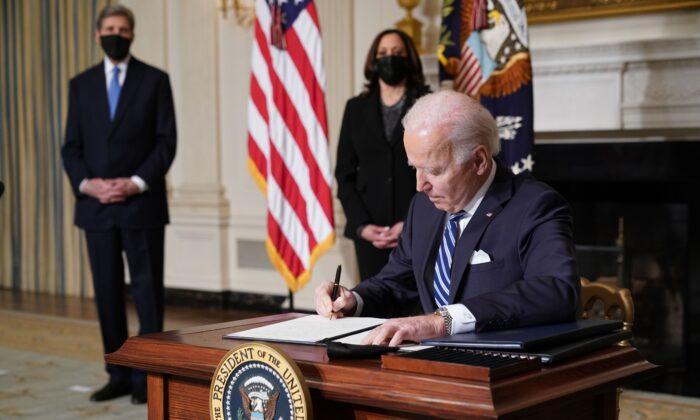The Biden administration has implemented multiple policies that have harmed America’s domestic energy production and weakened the country’s standing internationally leading to gas shortages and the highest-ever prices in the nation’s history.
Immediately after becoming president, Biden implemented a series of measures aimed at limiting fossil fuel use. This included canceling the Keystone XL pipeline, issuing a moratorium on all oil and natural gas leasing activities in the Arctic National Wildlife Refuge, and revoking Trump-era orders that decreased regulations on federal land while expanding the ability to produce energy domestically.
Biden implemented measures that artificially raised the regulatory costs of fossil fuel energy production. He also issued an executive order announcing a moratorium on new oil and gas leases on public lands or in offshore waters as well as reconsideration of federal oil and gas permitting and leasing practices.
The president then signed an executive order that directed agencies to eliminate federal fossil fuel subsidies wherever possible, thus putting oil and gas firms at a disadvantage compared to other energy sources that received direct subsidies. All this was done in just the first ten days in office.
Under the current administration, energy prices have surged. When Biden became president in January 2021, gas prices were around $2.478 per gallon, which has now jumped to $3.645 as of May 22, an increase of over 47 percent.
Harmful Energy Policies
In February 2021, Biden made America officially rejoin the Paris Climate Agreement, which IER points out is “detrimental to Americans while propping up oil production in Russia and OPEC and increasing the dependence of Europe on Russian oil and natural gas.”It also benefits China, which “dominates the supply chain for critical minerals that are needed for wind turbines, solar panels, and electric vehicle batteries.”
In April 2021, Secretary of the Interior Deb Haaland revoked policies in Secretarial Order 3398 set by the Trump administration, thereby rejecting “American energy independence” as a goal, rejecting an “America-first offshore energy strategy,” and doing away with setting up an “executive committee for expedited permitting.”
“These actions set the stage for the unprecedented slowdown in energy activity by the Interior Department, steward of 2.46 billion acres of federal mineral estate and all its energy and mineral resources,” IER said.
In October 2021, the Department of Labor issued a final rule that would require fiduciaries to take into account environmental, social, and governance (ESG) factors as well as the economic effects of climate change when evaluating funds for retirement plans. This had the effect of encouraging capital withdrawal from the domestic oil and gas sector, IER states.
In June 2022, the Interior Department announced that it would reduce fees on renewable projects on federal lands after earlier saying that royalties and rents for oil and gas projects on federal lands would increase by as much as 50 percent.
In August 2022, Biden signed into law the Inflation Reduction Act (IRA) which included new taxes on methane leaks and natural gas extraction as well as taxes on crude oil and related products. The Act extended biofuel tax credits and instituted a new tax credit for sustainable aviation fuel.
“These biofuel tax credits will encourage existing petroleum refining capacity to convert to biofuels, making it harder for Americans to get the petroleum fuel products they need for transportation and home heating,” IER said.
“These incentives will make the United States import more petroleum products from countries with additional capacity such as China and the Middle East, while committing more agricultural products to fuel, rather than food.”
In March 2023, the Environmental Protection Agency (EPA) announced the “Good Neighbor” rule that sets tougher limits on emissions from industrial facilities, power plants, and factories that cross state boundaries. The rule “increases the costs of electricity for consumers” and can place “tighter constraints on emissions from 23 Midwestern and Western states that have coal and natural gas power plants and facilities.”
In April 2023, the EPA released rules aimed to ensure that electric cars make up 54 to 60 percent of all new cars sold in the United States by 2030, a target that rises to 64 to 67 percent by 2032.
Cost of Renewables
In an interview with The Epoch Times, Mark Mills, a senior fellow at the Manhattan Institute and a professor at Northwestern University’s School of Engineering and Applied Science, pointed out that the shift away from fossil fuels to renewable energy would not be as clean as claimed.The transition involves “going from a system dominated by liquid hydrocarbons and gaseous hydrocarbons to one dominated by solid minerals and rocks and metals.”
But since minerals are less energy dense compared to fossil fuels, “it takes, depending on the machines, somewhere between 1,000 percent and 5,000 percent greater use of minerals to produce the same amount of energy.”
When building machines like wind turbines, there will be a big increase in the quantity of minerals and metals that have to be mined, he pointed out.
White House Stance
While implementing steps that end up curtailing the domestic oil and gas industry, the Biden administration has also sought to stress that it has supported the sector.In March 2022, Biden blamed the oil sector for not utilizing the drilling permits, pointing out that his administration has approved 9,000 permits.
However, this is the lowest percentage of unused leases in at least two decades, IER points out in its report. “In other words, lease utilization is at a multi-decade high.”
But despite the high production claim of the press secretary, oil production has actually suffered under the Biden administration according to Oliver McPherson-Smith, director for energy, trade, and environmental policy at the American Consumer Institute.
Criticizing Biden’s Policies
Several organizations have criticized Biden’s anti-fossil fuel policies. In November last year, Power the Future, a nonprofit group representing energy industry workers, said in a report that when Republicans take a majority in Congress, they “should not only conduct oversight—they should pursue pro-energy policies for the country.”“Since the start of his presidency, Biden has indulged in apocalyptic concerns about climate change at the expense of American energy production, workers, and consumers,” it stated.
Calling the White House’s energy policies “disastrous,” the report said that the Biden administration’s adherence to ESG policies has resulted in a reduction in investments in fossil fuels.
This month, the U.S. Chamber of Commerce issued a statement criticizing the EPA’s proposed power plant rules that require steep pollution cuts from the country’s power infrastructure which mostly uses natural gas and coal.
“Regulations must be grounded in what is technologically feasible and commercially available. Going beyond that, as this regulation does, could threaten electric reliability and raise energy prices to unsustainable levels, harming the entire economy.”





